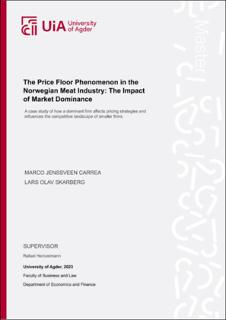| dc.description.abstract | This master thesis explores how a dominant firm affect the Norwegian meat industry. We investigate how smaller firms can independently establish their own prices for buying carcasses. Furthermore, we elaborate how the presence of a dominant player affects the competitive landscape and pricing strategies of smaller firms and how import undermine Norwegian price levels.
We employ a qualitative case study approach; we conducted interviews to obtain reliable and authentic data on how the Norwegian meat market functions and its implication on smaller firms. By applying a basic economic theory such as supply and demand, we uncover the effects the dominant player has on price decisions of smaller producers, the competitive landscape, and regulatory measures.
Our data and analysis allow us to categorize the market into two main participants, the cooperative and non-cooperative firms. Where smaller independent firms possess a degree of pricing autonomy. Competing on additional rates offered to farmers and improve cost efficiency, however, there exists a fixed price floor in the Norwegian meat market, directly influenced by the offerings of the regulator. The regulator effectively controls market conditions and as a result smaller firms have formed partnerships to bypass trade with the regulator. Our findings reveals that the price level of carcasses in Norway is not solely based on domestic supply and demand, even though Norway is considered a sealed off market. Import quotas, intended to supplement domestic production shortfalls and act as a price control, have in 2023 contributed to an upward pressure on carcasses prices.
The thesis aims to offer a deeper understanding of the market structure in the agricultural meat sector. With a dominant player controlling a significant share of the market, the Norwegian meat industry presents an alternative to more commonly studied competitive markets. An exploration of how the industry operates under these conditions, with regulations, hopefully will give a better understanding of how political and economic factors affect pricing and competition. | |
